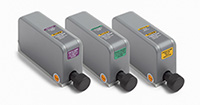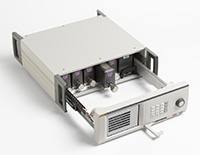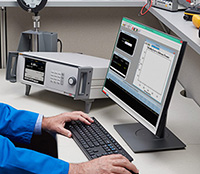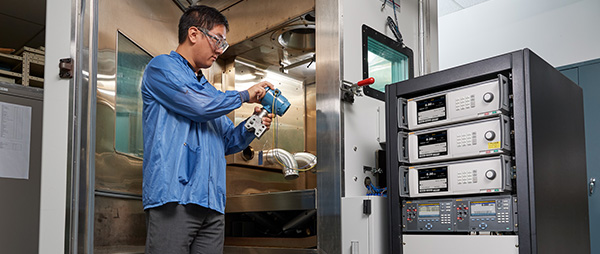- Other Fluke companies:
- Fluke
- Fluke Biomedical
- Fluke Networks
- Fluke Process Instruments
Technology and Automation in Modular High-Pressure Controllers
Two of the most common reasons to upgrade to an 8270A or 8370A Modular High-Pressure Controller are the desire to increase throughput efficiency and the need to increase accuracy or pressure range capabilities. Often, metrologists are also looking for scalable technology and instruments that can be automated.
Technology Behind Pressure Coverage
The technology in Fluke Calibration modular pressure calibrators that enables wide pressure coverage is driven by the variety of the pressure measurement modules we have for them. We began developing these modules several years ago for the predecessor to the 8270A and 8370A, the 6270A Pressure Controller / Calibrator. The 6270A controller ranges from vacuum pressure to 3,000 PSI. We developed a wide variety of modules for the 6270A, and we built on that technology for the 8270A and 8370A.
Essentially, this technology is not brand new with inherent technological risk. The 8270A and 8370A are iterative controllers based on existing, trusted products. The pressure measurement modules for the 8270A and 8370A are available in three accuracy levels: good, better, and best. Customers can choose modules that best fit their needs and budget.
|
Good: PM200 Pressure Measurement Modules |
Better: PM500 Pressure Measurement Modules |
Best: PM600 Measurement Modules |
|
|
|
Budgets are always tight. Calibration experts need to have a solution that makes the most efficient use of their limited funding. We have the widest variety of pressure measurement modules so that customers can mix and match to meet their needs.

The system itself automatically recognizes what modules are installed and selects the most accurate module for the measurement involved. This makes the system very intuitive without need for calculations. It also creates the ability to have a wide variety of ranges and accuracy even within one system.
For example, a calibration specialist might need high pressure at a relatively standard accuracy level, but he needs more accuracy at lower pressure levels. He could have a mix of standard and high accuracy modules matched to the pressure ranges he needs to hit, and thus have a more efficient system for a wide range of pressure coverage.
The pressure measurement modules work in conjunction with a pressure controller module, which, in a simplified view, you can think as two valves – one from a high-pressure supply and one that exhausts to atmosphere (or, in the case of the 8270A, to a vacuum pump). The system controls the commanded pressure to the device by simply regulating these valves. Our engineers have put extraordinary work into making this system highly accurate.
Consolidating to Save Time and Space
The flexibility is a huge advantage, especially if your space is limited. You could consolidate several fixed controllers with one or two pressure ranges into one system, and effectively replace several bench devices. The 8270A and 8370A can hold up to five pressure measurement modules at one time, but they are interchangeable. It’s possible to have more than five modules and swap them in and out when necessary.
This interchangeability can be especially convenient when you need to calibrate the system. The modules are the only pieces that requires calibration, so you can keep the controller working. You could even have modules on a staggered calibration cycle to prevent downtime as you wait for a module to come back from calibration.
As we continue to develop newer and more accurate modules, you should be able to continue to plug them into your existing system. This could prevent you from needing to purchase additional devices in the future. You would just buy new modules.
Improving on the 6270A
The main advantage of the 8270A or 8370A over the 6270A is the available pressure ranges.
There are some ranges that all products can handle, and there are some pressures ranges that only one of the given controllers can handle. It’s all driven by the customer’s application. Everyone’s application is a little bit different, and there is rarely a one-size-fits-all kind of need.

When building a solution for any calibration specialist, we are always trying to find the most efficient way to meet their needs with the hardware available. Fortunately, with the modular 8270A, 8370A, and 6270A, we are able to offer them a lot of options.
A nice additional feature for all of these controllers is the plethora of computer interfaces on the controller. Not everyone uses these. Some prefer to run the instrument from the front of the panel, but, for those looking to automate systems or plug these into production-type test scenarios, the fact that USB and Ethernet ports come standard with the controller along with the traditional serial and GPIB buses is a huge advantage.
This gives a certain degree of future-proofing to the controller’s interface. If a person was going to pick a computer interface technology that was going to survive into the foreseeable future, it would probably be Ethernet or ISB. The fact that those are included on the controller allows some reassurance that you will be able to continue to interface with the product moving forward.
Automation
Automation and remote use are common in product or manufacturing businesses, where throughput becomes critical. If the organization is smaller or only has one controller, then automation is less common. With automation, you could potentially run 24 hours a day. With a manual-based system, the cost to do that grows exponentially.
Automation isn’t exclusively interesting to large teams. Automation becomes a desirable feature for anyone who intends to grow their business.

Sometimes, a calibration specialist is tired of filling out calibration certificates by hand and decides that he/she wants to automate with our off-the-shelf Compass™ for Pressure software. This setup could be as simple as having a single computer in the lab that is connected to the controller via USB. They hook up the controller and generate certificates right there. This use case makes sense, especially for small to medium size organizations.
There are a few routes you can take if you’re interested in receiving training for automation.
- Users can install a piece of trial software for free for 60 days.
- We offer on-site training and setup on the software.
- The third way, and maybe the easiest way, is just to give us a call.
Our team can talk through your use case and determine the best course of action for what you want to accomplish. With a quick, technical call, we can often determine what the best route would be for you to accomplish what you’re hoping to achieve with automation.
Summary
Those looking to upgrade to a high-pressure, modular system might consider the 8270A or 8370A Modular High-Pressure Controller. The 8270A and 8370A are pneumatic pressure controllers that can save time, consolidate space, and achieve pressure ranges as high as 15000 PSI.
The 8270A and 8370A are also capable of automation. Users can choose the level at which they would like to automate their procedures. They can manually operate the device from the front panel, build stored procedures into the device, or run the device remotely with software.
Keep learning
Three Reasons to Consider a Modular Pressure Control System
Commonly Asked Questions about the 8270A and 8370A High-Pressure Controllers
Equipment Tips for Pressure Controllers in the Production Process
Related products
8270A and 8370A Modular High-Pressure Controllers / Calibrators
Get Help
Speak with a calibration product expert about your equipment needs
- Home
- Products
- New Products
- Electrical Calibration
- RF Calibration
- Data Acquisition and Test Equipment
- Temperature Calibration
- Humidity Calibration
- Pressure Calibration
- Flow Calibration
- Process Calibration Tools
- Calibration Software
- Service and Support
- All Calibration Instruments
- Purchase Info
- News
- Training and Events
- Literature and Education
- Service and Support
- About Us



